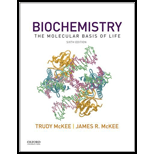
To review:
The standard free energy produced by the reduction of sulfur to hydrogen sulfide, and oxygen to water, by NADH (reduced nicotinamide adenine dinucleotide), and the free energy produced by reduction of oxygen in comparison to sulfur.
Introduction:
Gibbs free energy is the potential that can be used for the calculation of maximum reversible work that is performed at constant temperature and pressure. The phosphoryl group transfer potential of a compound can be defined as ameasure of the strength of attachment of a group to amolecule. It usually refers to the differences in the standard free energies of the molecule with and without the group.
Explanation of Solution
The reduction of sulfur to hydrogen sulfide by NADH can be depicted as follows:
For calculating the standard free energy, thenumber of electrons transferred needs to be balanced. For a reaction, the standard free energy can be calculated by using the Nernst equation, which is as follows:
Where,
n is the number of electrons transferred,
F is Faraday’s constant, which is 96.15 kJ/V.mol (kilojoule per Volt. mole) and
∆E°’ is overall cell potential.
∆E°’ can be calculated by the following formula:
The value of standard reduction potentials (Eº’) for the electron acceptor, in this case, is -0.23V and for the electron donor is -0.32V. Therefore,
Putting the values of n, F, and ∆E°’ in the Nernst equation:
Thus, the standard free energy of the reaction is -15.93kJ/mol.
The reduction of oxygen to water by NADH can be depicted as follows:
For calculating the standard free energy, thenumber of electrons transferred needs to be balanced. For a reaction, the standard free energy can be calculated by using the Nernst equation.
Thus,
The value of standard reduction potentials (Eº’) for the electron acceptor, in this case, is 0.82 V and for the electron donor is –0.32 V. Therefore,
Putting the values of n, F, and ∆E°’ in the Nernst equation:
Thus, the standard free energy of the reaction is–219.222 kJ/mol.
Thus, it can be concluded that the standard free energy of reduction of sulfur to hydrogen sulfide is –15.93 kJ/mo, lnd the standard free energy of reduction of oxygen to water is –219.222 kJ/mol.
Want to see more full solutions like this?
Chapter 9 Solutions
Biochemistry: The Molecular Basis of Life
- Which features of the curves in Figure 30-2 indicates that the enzyme is not consumed in the overall reaction? ES is lower in energy that E + S and EP is lower in energy than E + P. What does this tell you about the stability of ES versus E + S and EP versus E + P.arrow_forwardLooking at the figure 30-5 what intermolecular forces are present between the substrate and the enzyme and the substrate and cofactors.arrow_forwardprovide short answers to the followings Urgent!arrow_forward
- Pyruvate is accepted into the TCA cycle by a “feeder” reaction using the pyruvatedehydrogenase complex, resulting in acetyl-CoA and CO2. Provide a full mechanismfor this reaction utilizing the TPP cofactor. Include the roles of all cofactors.arrow_forwardB- Vitamins are converted readily into important metabolic cofactors. Deficiency inany one of them has serious side effects. a. The disease beriberi results from a vitamin B 1 (Thiamine) deficiency and ischaracterized by cardiac and neurological symptoms. One key diagnostic forthis disease is an increased level of pyruvate and α-ketoglutarate in thebloodstream. How does this vitamin deficiency lead to increased serumlevels of these factors? b. What would you expect the effect on the TCA intermediates for a patientsuffering from vitamin B 5 deficiency? c. What would you expect the effect on the TCA intermediates for a patientsuffering from vitamin B 2 /B 3 deficiency?arrow_forwardDraw the Krebs Cycle and show the entry points for the amino acids Alanine,Glutamic Acid, Asparagine, and Valine into the Krebs Cycle - (Draw the Mechanism). How many rounds of Krebs will be required to waste all Carbons of Glutamic Acidas CO2?arrow_forward
- Sodium fluoroacetate (FCH 2CO2Na) is a very toxic molecule that is used as rodentpoison. It is converted enzymatically to fluoroacetyl-CoA and is utilized by citratesynthase to generate (2R,3S)-fluorocitrate. The release of this product is a potentinhibitor of the next enzyme in the TCA cycle. Show the mechanism for theproduction of fluorocitrate and explain how this molecule acts as a competitiveinhibitor. Predict the effect on the concentrations of TCA intermediates.arrow_forwardIndicate for the reactions below which type of enzyme and cofactor(s) (if any) wouldbe required to catalyze each reaction shown. 1) Fru-6-P + Ery-4-P <--> GAP + Sed-7-P2) Fru-6-P + Pi <--> Fru-1,6-BP + H2O3) GTP + ADP <--> GDP + ATP4) Sed-7-P + GAP <--> Rib-5-P + Xyl-5-P5) Oxaloacetate + GTP ---> PEP + GDP + CO 26) DHAP + Ery-4-P <--> Sed-1,7-BP + H 2O7) Pyruvate + ATP + HCO3- ---> Oxaloacetate + ADP + Piarrow_forwardTPP is also utilized in transketolase reactions in the PPP. Give a mechanism for theTPP-dependent reaction between Xylulose-5-phosphate and Ribose-5-Phosphate toyield Glyceraldehyde-3-phosphate and Sedoheptulose-7-Phosphate.arrow_forward
 Principles Of Radiographic Imaging: An Art And A ...Health & NutritionISBN:9781337711067Author:Richard R. Carlton, Arlene M. Adler, Vesna BalacPublisher:Cengage Learning
Principles Of Radiographic Imaging: An Art And A ...Health & NutritionISBN:9781337711067Author:Richard R. Carlton, Arlene M. Adler, Vesna BalacPublisher:Cengage Learning





